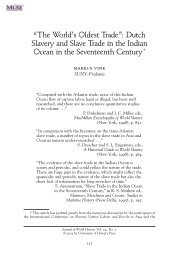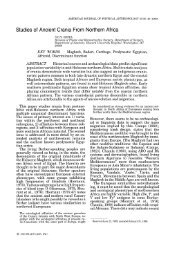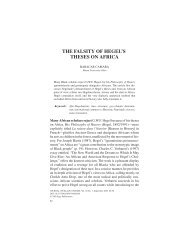THE MILITARY SYSTEM OF BENIN KINGDOM, c.1440 - 1897
THE MILITARY SYSTEM OF BENIN KINGDOM, c.1440 - 1897
THE MILITARY SYSTEM OF BENIN KINGDOM, c.1440 - 1897
You also want an ePaper? Increase the reach of your titles
YUMPU automatically turns print PDFs into web optimized ePapers that Google loves.
the state functionaries which had beset the ruling dynasty from the reign of Eweka I c.1200AD. However, conflicts between the Oba and his chiefs continued. During the seventeenthcentury, the military and administrative chiefs came to overshadow the king, reducing him toa ritual figure, although the non-hereditary chiefs held their power and privileges only by theauthority of the king. The opposition which faced the very first Oba, Eweka I in the earlythirteenth century was what led to the creation of a political institution known as the Uzama, 2“to establish some sense of order in the new polity.” 3 Although the Uzama continued to assertthemselves against the new kings, Oba Ewedo c.1255 AD “was forced to make changes in theorganisational structure of the state: in the end, the Oba emerged in supreme control and therespective cadres of authority were subordinated to the monarchy.” 4 This did not put an end tothe power rivalries, not even with the reforms introduced by Oba Ewuare. The powerstruggles continued, and were expressed in conflicts and crises. These, in turn, had importantramifications for the state and its military organisation. The records of change and continuityfrom 1440 to <strong>1897</strong> have been critically examined under the theme of the military system ofthe kingdom of Benin.The kingdom of Benin was one of the most important forest states of West Africaduring the precolonial period. Of all the West African states and societies, it is the one mostmentioned in contemporary European literature. 5 This also illustrates a number of important2 The original members of the Uzama were six: Oliha, Edohen, Ezomo, Ero, Eholo n’Ire, and Oloton. This groupof nobles held their positions and titles by hereditary rights except the Ezomo because the title was conferred onany warrior from any part of the Benin Empire In the fifteenth century, Oba Ewuare appointed the crown-princeknown as Edaiken as the seventh member of the Uzama. It was a development which reflected the powerdynamics of the period. The Uzama n’Ihinron (the seven Uzama) as it came to be known, were given theprivilege as elders of the state and king-makers because of their role in the restoration of the monarchy after thecollapse of the Ogiso dynasty - the first dynasty of kings - in the kingdom of Benin.3 Isidore Okpewho, 1998, Once Upon a Kingdom: Myth, Hegemony, and Identity. Bloomington & Indianapolis:Indiana University Press, p.69.4 ibid.5 This can be explained for two reasons. First of all, after the fall of Benin in February <strong>1897</strong> during the era ofEuropean scramble for and partition of Africa, thousands of the royal art of Benin were taken to Europe by theBritish conquerors. The technical sophistication and precious materials of the works of art were much admired;many were sold and a lot now adorn museums in Europe and the United States of America. The history of theobjects has been areas of continuing research and investigations. See for example, P. Girshick Ben-Amos, 1999,Art, Innovation, and Politics in Eighteenth Century Benin. Bloomington and Indianapolis: Indiana UniversityPress; B. W. Blackmun, 1997, Icons and Emblems in Ivory: Sacred Art from the Palace of Old Benin. The ArtInstitute of Chicago Museum Studies. Kate Ezra, 1992, Royal Art of Benin: The Pearls Collection in TheMetropolitan Museum of Art. New York: Harry N. Abrams Inc.; Bryna Freyer, 1987. Benin Royal Art in theCollection of the National Museum of African Art. Washington, D. C.: Smithsonian Institution; P. Girshick Ben-Amos and A. Rubin (eds.) 1983, The Art of Power, the Power of Art. Los Angeles: Fowler Museum of CulturalHistory, UCLA. Flora Kaplan, 1981, Images of Power: Art of the Royal Court of Benin. New York. Secondly,from the end of the fifteenth century up to the time of British conquest in February <strong>1897</strong>, European travellers,traders and consuls supplied information about Benin. This attracted the attention of scholars, whose interest inthe Benin past has yielded enormous amount of literature in Art history, anthropology, ethnography, archaeologyand history. See for example, Adam Jones, 1983, German Sources for West African History 1599-1669.Wiesbaden: Franz Steiner Verlag GmbH; Noel Matthews, 1973. Materials for West African History in theArchives of the United Kingdom. University of London: The Athlone Press; A. F. C. Ryder, 1965, Materials for2



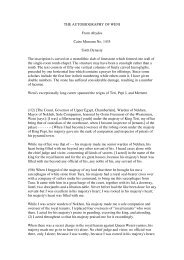
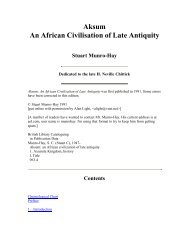
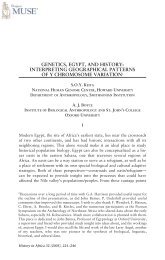

![The Negro trail blazers of California [microform] : a ... - Homestead](https://img.yumpu.com/32436613/1/174x260/the-negro-trail-blazers-of-california-microform-a-homestead.jpg?quality=85)
